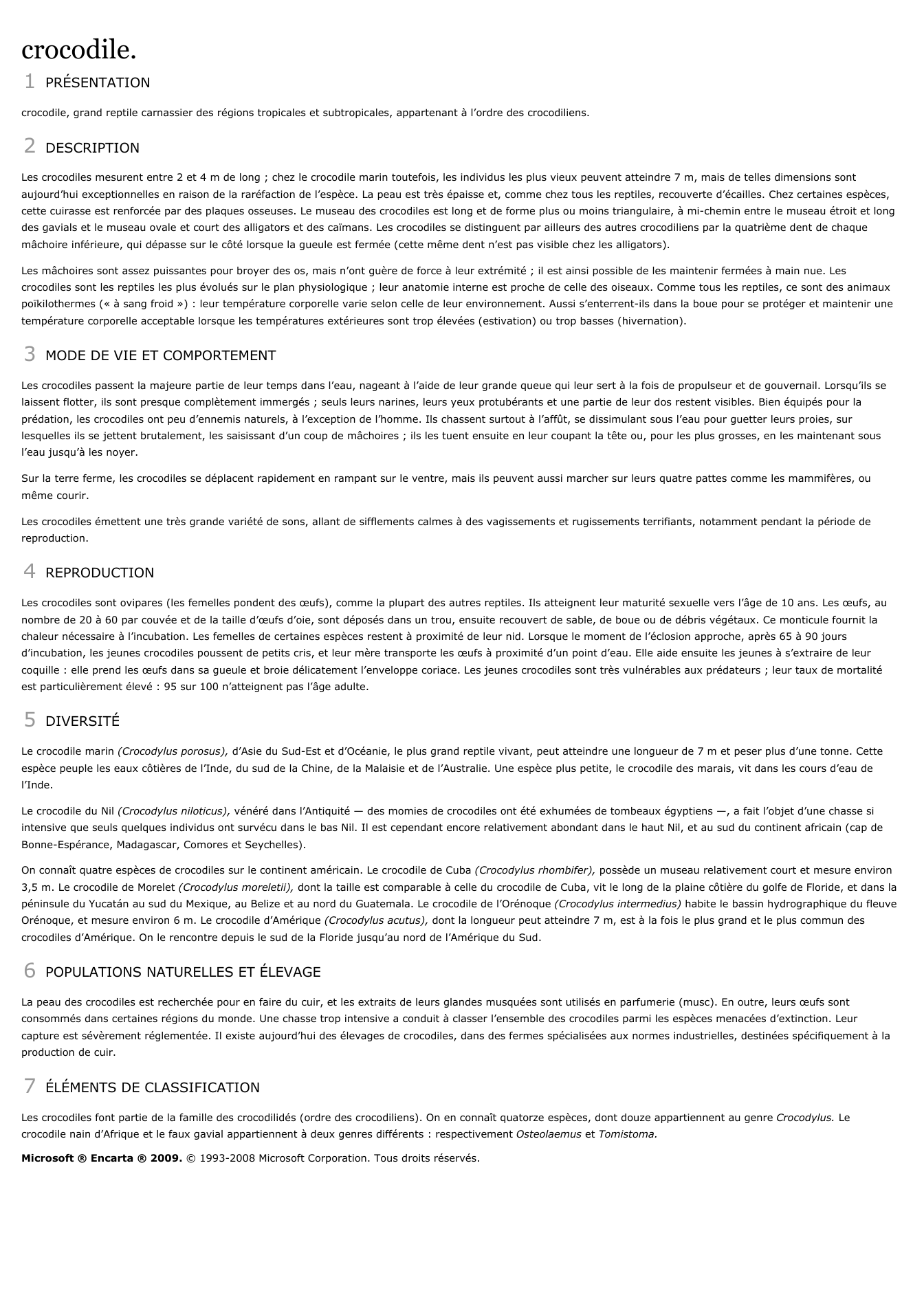Crocodile.
Publié le 06/12/2021

Extrait du document
Ci-dessous un extrait traitant le sujet : Crocodile.. Ce document contient 189 mots. Pour le télécharger en entier, envoyez-nous un de vos documents grâce à notre système d’échange gratuit de ressources numériques ou achetez-le pour la modique somme d’un euro symbolique. Cette aide totalement rédigée en format pdf sera utile aux lycéens ou étudiants ayant un devoir à réaliser ou une leçon à approfondir en : Echange
Crocodile.
Class Reptilia
Order Crocodylia
Family Crocodylidae
Genus Crocodylus
Conservation Several species are endangered due to hunting and habitat destruction.
Concerns
Range Tropical regions worldwide.
Habitat Shallow bodies of water, including swamps, marshes, and rivers.
Size Largest: The estuarine, or saltwater, crocodile grows up to 7 m (23 ft) in length, and weighs up to 1000 kg (2200 lb).
Smallest: The African dwarf crocodile grows to about 1.9 m (6.2 ft).
Feeding Habits Crocodiles are carnivores; they eat fish, birds, turtles, frogs, and mammals. Young crocodiles eat worms, small fish, and insects.
Offspring The female crocodile lays up to 90 eggs and buries them. In some species, the female remains with the eggs, and assists the
hatchlings to water.
Life Span Up to 65 years.
Did You Know Unlike an alligator, a crocodile's two large lower teeth are visible when its jaw is closed.
A baby crocodile breaks out of its egg with a special hard tip on its snout.
The estuarine crocodile is the largest known living reptile.
Crocodiles have no sweat glands. They lose heat through their mouths, and sometimes pant like dogs to keep cool.
Microsoft ® Encarta ® 2009. © 1993-2008 Microsoft Corporation. All rights reserved.
Crocodile.
Class Reptilia
Order Crocodylia
Family Crocodylidae
Genus Crocodylus
Conservation Several species are endangered due to hunting and habitat destruction.
Concerns
Range Tropical regions worldwide.
Habitat Shallow bodies of water, including swamps, marshes, and rivers.
Size Largest: The estuarine, or saltwater, crocodile grows up to 7 m (23 ft) in length, and weighs up to 1000 kg (2200 lb).
Smallest: The African dwarf crocodile grows to about 1.9 m (6.2 ft).
Feeding Habits Crocodiles are carnivores; they eat fish, birds, turtles, frogs, and mammals. Young crocodiles eat worms, small fish, and insects.
Offspring The female crocodile lays up to 90 eggs and buries them. In some species, the female remains with the eggs, and assists the
hatchlings to water.
Life Span Up to 65 years.
Did You Know Unlike an alligator, a crocodile's two large lower teeth are visible when its jaw is closed.
A baby crocodile breaks out of its egg with a special hard tip on its snout.
The estuarine crocodile is the largest known living reptile.
Crocodiles have no sweat glands. They lose heat through their mouths, and sometimes pant like dogs to keep cool.
Microsoft ® Encarta ® 2009. © 1993-2008 Microsoft Corporation. All rights reserved.
↓↓↓ APERÇU DU DOCUMENT ↓↓↓
Liens utiles
- Un crocodile monstrueux, dont le corps était à demi caché sous les roseaux et les mangles de la rivière, avait passé sa tête énorme à travers l'une des arcades de verdure qui soutenaient le toit du pavillon. Victor Hugo, Bug-Jargal, ABU, la Bibliothèque universelle
- crocodile.
- Crocodile de Thaïlande:Sauvé de l'extinction pour la valeur de sa peau.
- Crocodile de Cuba:Il se raréfie et risque l'extinction.
- Crocodile marin


